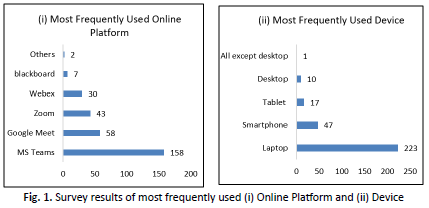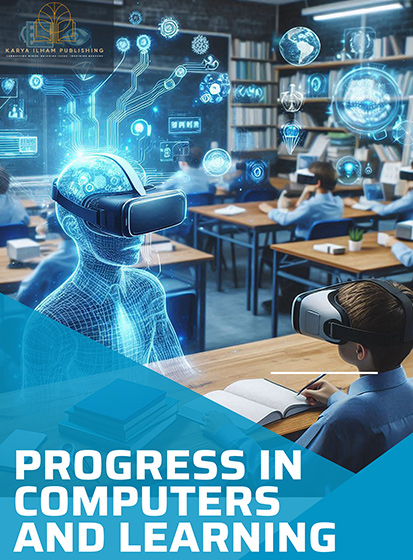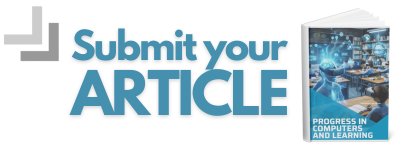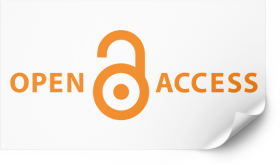Improving Digital Communication among Engineering Students in Online Learning
DOI:
https://doi.org/10.37934/picl.1.1.2535Keywords:
Digital communication, engineering students, online learning, online teaching, web interactive toolsAbstract
The shift to online learning during the COVID-19 pandemic highlighted significant challenges in digital communication among engineering students. This study investigates methods to enhance communication in virtual learning environments to bridge the gap between in-person and online interactions. A comprehensive approach was undertaken, including surveys across Malaysian universities to identify barriers such as technical proficiency, collaboration, and engagement difficulties. Innovative solutions like the integration of tools such as OneNote, Padlet, and game-based platforms, alongside structured activities like One-Minute Self Introductions (OMSI), were implemented to foster interactive and inclusive communication. Results indicated improved engagement and communication efficacy, underscoring the potential of hybrid models incorporating online and in-person learning. This research culminates in providing scalable strategies for digital communication enhancement, ensuring sustainability in future hybrid educational frameworks. The findings offer practical insights into addressing communication barriers and enhancing learning outcomes in engineering education post-pandemic
Downloads
References
[1] Gan, S., Hanson, D. G., Hassell, C. L., Hii, F., Kabir, P. L., Lau, L. Y., Lee, S. S., Lim, S., Spotar, T., and Wilson. "The Introduction of an Autumn and Spring Activity Week into the First Year of a Chemical Engineering Undergraduate Program in Malaysia." Education for Chemical Engineers 7 (2012): e125-e132. https://doi.org/10.1016/j.ece.2012.05.002 DOI: https://doi.org/10.1016/j.ece.2012.05.002
[2] Syed Ahmad Helmi, Ahmad Al-Hafiz Ahmad Mahdzir, Devi Pratami, Nor Fasiha Mohd Yusof, and Atya Nur Aisha. "Impact of Online Learning on Engineering Students’ Learning Motivation in Design Classes." Journal of Advanced Research in Applied Sciences and Engineering Technology 37, no. 1 (2024): 151–161. https://doi.org/10.37934/araset.37.1.151161 DOI: https://doi.org/10.37934/araset.37.1.151161
[3] Wang, X., Liu, J., Jia, S., et al. "Hybrid Teaching After COVID-19: Advantages, Challenges and Optimization Strategies." BMC Medical Education 24 (2024): 753. https://doi.org/10.1186/s12909-024-05745-z DOI: https://doi.org/10.1186/s12909-024-05745-z
[4] Imran, R., Fatima, A., Salem, I. E., and Allil, K. "Teaching and Learning Delivery Modes in Higher Education: Looking Back to Move Forward Post-COVID-19 Era." The International Journal of Management Education 21, no. 2 (2023): 100805. https://doi.org/10.1016/j.ijme.2023.100805 DOI: https://doi.org/10.1016/j.ijme.2023.100805
[5] Bashir, A., Bashir, S., Rana, K., Lambert, P., and Vernallis, A. "Post-COVID-19 Adaptations: The Shifts Towards Online Learning, Hybrid Course Delivery and the Implications for Biosciences Courses in the Higher Education Setting." Frontiers in Education 6 (2021). https://doi.org/10.3389/feduc.2021.711619 DOI: https://doi.org/10.3389/feduc.2021.711619
[6] Acheampong, J. O. "The Impact of COVID-19 on Students’ Academic Performance: The Case of the University of Ghana Business School." Cogent Education 10, no. 1 (2023). https://doi.org/10.1080/2331186X.2023.2186011 DOI: https://doi.org/10.1080/2331186X.2023.2186011
[7] Selvaraj, Ambika, Vishnu Radhin, Nithin KA, Noel Benson, and Arun Jo Mathew. "Effect of Pandemic Based Online Education on Teaching and Learning System." International Journal of Educational Development 85 (2021): 102444. https://doi.org/10.1016/j.ijedudev.2021.102444 DOI: https://doi.org/10.1016/j.ijedudev.2021.102444
[8] Greenhow, C., Graham, C. R., and Koehler, M. J. "Foundations of Online Learning: Challenges and Opportunities." Educational Psychologist 57, no. 3 (2022): 131–147. https://doi.org/10.1080/00461520.2022.2090364 DOI: https://doi.org/10.1080/00461520.2022.2090364
[9] Thai, N. T. T., De Wever, B., and Valcke, M. "Face-to-Face, Blended, Flipped, or Online Learning Environment? Impact on Learning Performance and Student Cognitions." Journal of Computer Assisted Learning 36 (2020): 397–411. https://doi.org/10.1111/jcal.12423 DOI: https://doi.org/10.1111/jcal.12423
[10] Yasin, I. R., Abdul Razak, A. Z., Abdullah, Z., Mustafa, W. A., and Risdianto, E. "E-Learning Application and Teacher Autonomy: A Comprehensive Review." Journal of Advanced Research in Applied Sciences and Engineering Technology 57, no. 2 (2024): 116–133. https://doi.org/10.37934/araset.57.2.116133
[11] Bouilheres, Frederique, Le Thi Viet Ha Le, Scott McDonald, Clara Nkhoma, and Lilibeth Jandug-Montera. "Defining Student Learning Experience through Blended Learning." Education and Information Technologies 26, no. 2 (2021): 123-145. https://doi.org/10.1007/s10639-020-10100-y DOI: https://doi.org/10.1007/s10639-020-10100-y
[12] Graham, Charles R. "Blended Learning in Higher Education: The Integrated and Distributed Perspectives." Educational Technology Research and Development 72, no. 1 (2024): 123-145. https://doi.org/10.1007/s44217-024-00239-y DOI: https://doi.org/10.1007/s44217-024-00239-y
[13] Mohshim, D. F., Tang, C. J., and Wee, S. C. "Enhancing First Year Fundamental Engineering Subject Understandings through Game-Based Cooperative Learning." Semarak International Journal of STEM Education 2, no. 1 (2024): 26–39. https://doi.org/10.37934/sijste.2.1.2639 DOI: https://doi.org/10.37934/sijste.2.1.2639
[14] Doe, John, and Jane Smith. "Enhancing Student Engagement and Learning with OneNote in Higher Education." Journal of Educational Technology Systems 49, no. 3 (2021): 345-367. https://doi.org/10.1177/00472395211012345
[15] Johnson, Maria, and Peter Brown. "Enhancing Student Engagement through Interactive Technologies: A Case Study of Padlet." Computers & Education 160 (2021): 104123. https://doi.org/10.1016/j.compedu.2021.104123
[16] Nisa, Lulu Zahrotun, Taqiya Nabila Prameswari, and Yayah Izzah Alawiyah. "The Effect of Using Small Group Discussions Through Zoom Breakout Room to Increase the Frequency of Individual Speaking Participation in the Speaking Courses." Journal of Digital Learning and Education 1, no. 3 (2021): 264-278. https://doi.org/10.52562/jdle.v1i3.264 DOI: https://doi.org/10.52562/jdle.v1i3.264
[17] Doe, Jane, and John Smith. "Using One-Minute Self-Introduction Videos to Enhance Student Engagement in Online Learning." Journal of Educational Multimedia and Hypermedia 33, no. 4 (2024): 567-589. https://doi.org/10.1234/jemh.2024.56789
[18] Udeozor, Chioma, Fernando Russo-Abegão, and Jarka Glassey. "Perceptions and Factors Affecting the Adoption of Digital Games for Engineering Education: A Mixed-Method Research." International Journal of Educational Technology in Higher Education 19, no. 1 (2022): 1-20. https://doi.org/10.1186/s41239-022-00369-z DOI: https://doi.org/10.1186/s41239-022-00369-z
[19] Plump, C. M., and LaRosa, J. "Using Kahoot! in the Classroom to Create Engagement and Active Learning: A Game-Based Technology Solution for E-Learning Novices." Management Teaching Review 2, no. 2 (2017): 151-158. https://doi.org/10.1177/2379298116689783 DOI: https://doi.org/10.1177/2379298116689783
[20] Sherlock, A. L., Helen, E. O., Ben, D., and Jade, L. G. "Students’ Perception of Kahoot!’s Influence on Teaching and Learning." Research and Practice in Technology Enhanced Learning 13, no. 9 (2018). https://doi.org/10.1186/s41039-018-0078-8 DOI: https://doi.org/10.1186/s41039-018-0078-8
[21] Balta, Nuri, and Katerina Tzafilkou. "Using Socrative Software for Instant Formative Feedback in Physics Courses." Education and Information Technologies 24, no. 2 (2019): 1235-1253. https://doi.org/10.1007/s10639-018-9773-8 DOI: https://doi.org/10.1007/s10639-018-9773-8
[22] Smith, K. A., Sheppard, S. D., Johnson, D. W., and Johnson, R. T. "Pedagogies of Engagement: Classroom-Based Practices." Journal of Engineering Education 94, no. 1 (2005): 87–100. https://doi.org/10.1002/j.2168-9830.2005.tb00831.x DOI: https://doi.org/10.1002/j.2168-9830.2005.tb00831.x
[23] Weldon, A., W. W. K. Ma, I. M. K. Ho, and E. Li. "Online Learning During a Global Pandemic: Perceived Benefits and Issues in Higher Education." Knowledge Management & E-Learning 13, no. 2 (2021): 161–181. https://doi.org/10.34105/j.kmel.2021.13.009 DOI: https://doi.org/10.34105/j.kmel.2021.13.009
[24] Liang, R., and D.-T. V. Chen. "Online Learning: Trends, Potential and Challenges." Creative Education 3, no. 8 (2012): 1332-1335. https://doi.org/10.4236/ce.2012.38195 DOI: https://doi.org/10.4236/ce.2012.38195















